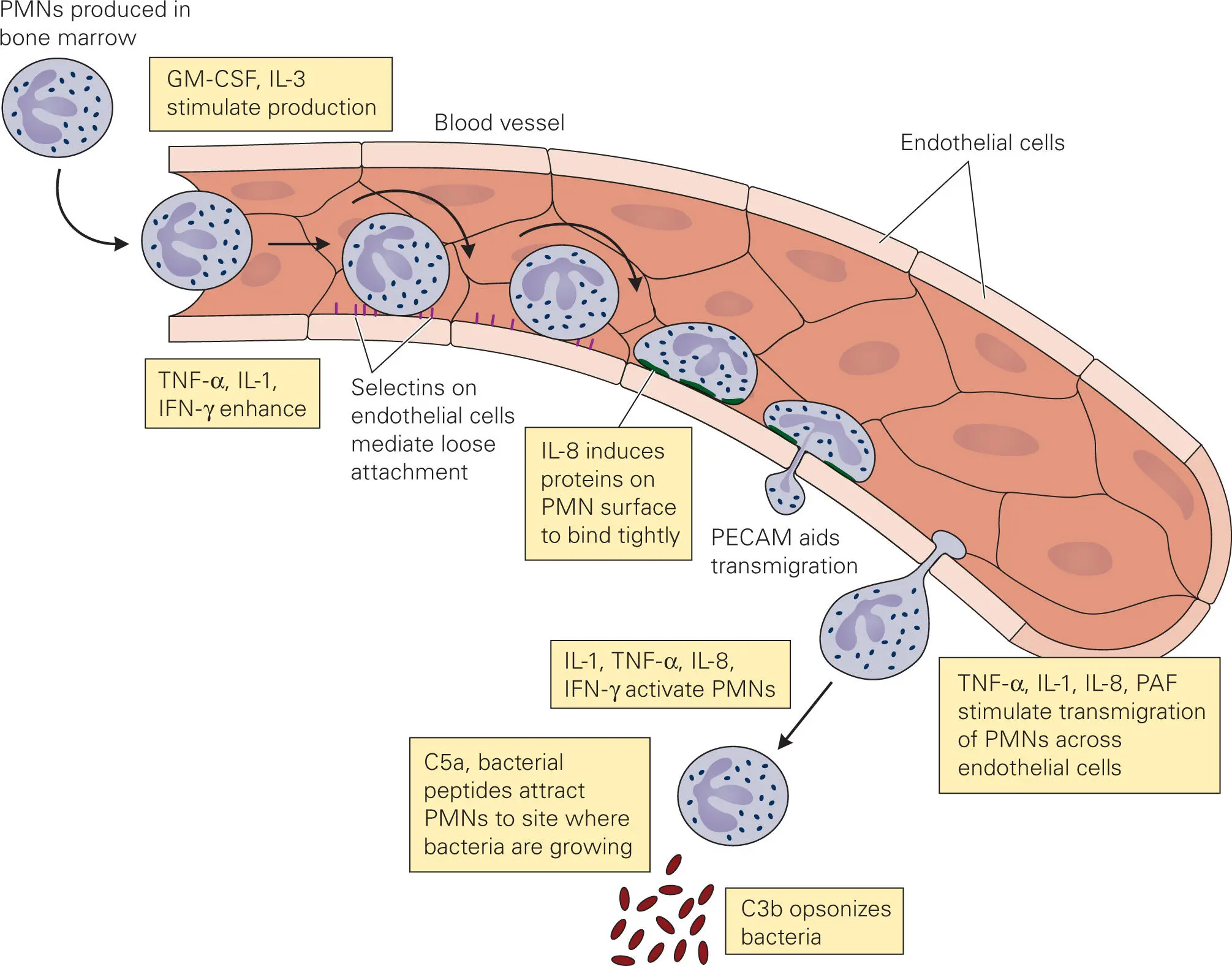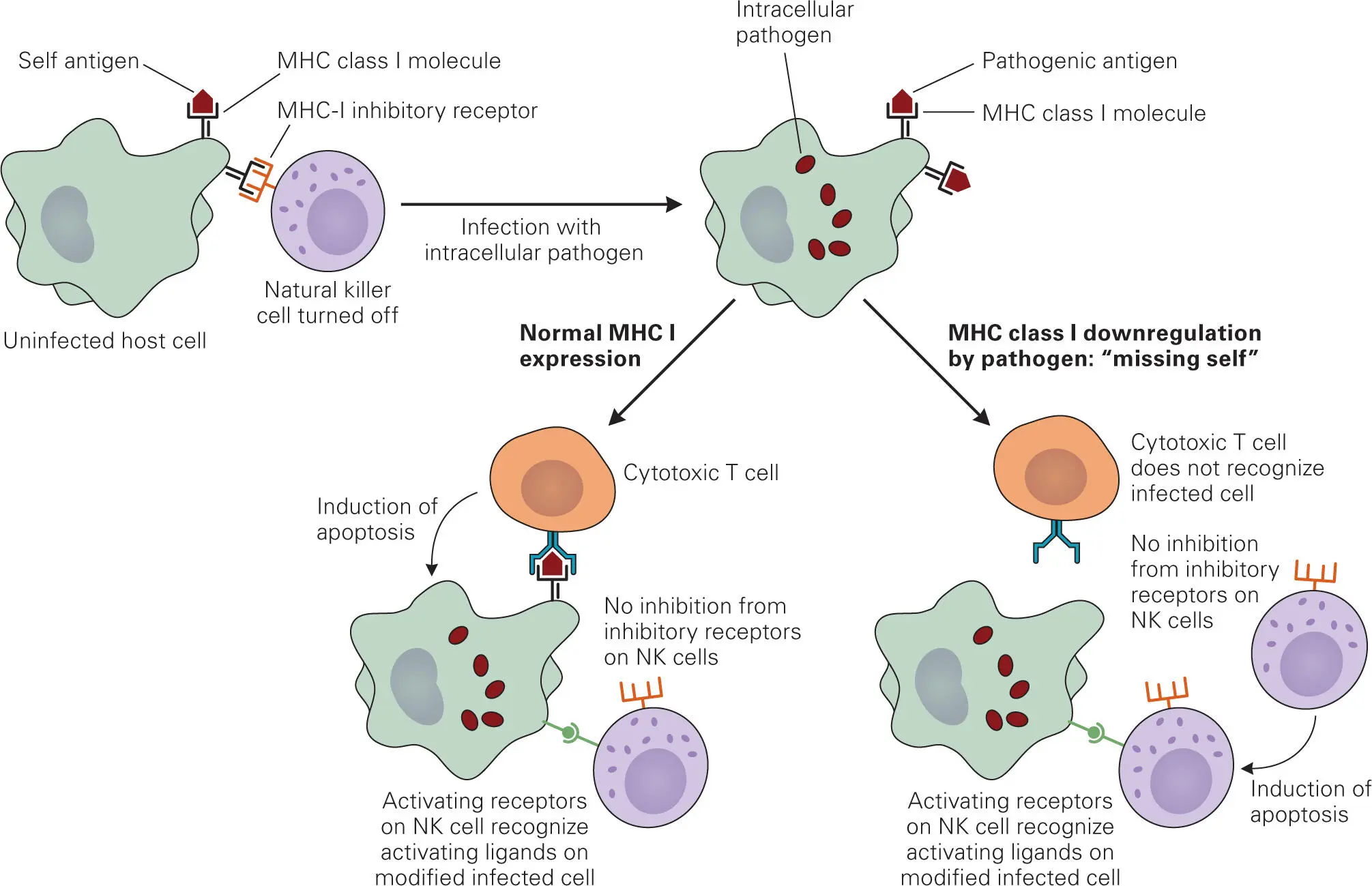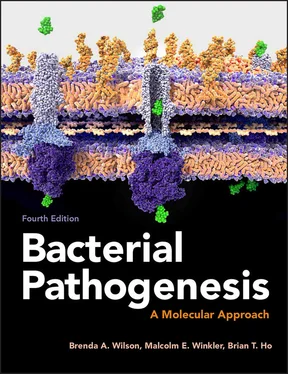How do PMNs know when to leave the blood vessels and where to go? Only when infection triggers signaling pathways that alert these cells to prepare for battle do the PMNs, monocytes, and NK cells pass through the blood vessel walls and enter tissues through a process called transmigration (also referred to as diapedesis or extravasation) ( Figure 3-2). Two groups of proinflammatory proteins alert PMNs to leave the bloodstream, and these proteins then guide the PMNs to their destination. One of these groups is the complement system, whose component C3a and C5a proteins are activated by contact with invading bacteria or by interaction with antibodies bound to foreign material. Once a PMN has moved out of the blood vessel, it follows a gradient of these complement components to the site where the bacteria have invaded (chemotaxis).

Figure 3-2. Roles of various cytokines and chemokines in directing the exit of neutrophils (PMNs) from the bloodstream at infection sites. Initially, new proteins are expressed on the surfaces of PMNs and endothelial cells, permitting a loose reversible binding. This gives PMNs a rolling motility as they flow through the blood vessel. Other cytokines cause changes in the cell surfaces resulting in tighter binding. The PMNs stop moving, flatten against the vessel wall, and force themselves across the endothelial wall. PMNs then move chemotactically along a C5a gradient. PAF, platelet-activating factor; PECAM, platelet-endothelial cell adhesion molecule.
The cytokines and chemokines are the second group of proteins ( Table 3-2). Cytokines and chemokines are produced by a number of human cell types, including monocytes, macrophages, PMNs, DCs, endothelial cells, fibroblasts, and cells of the adaptive immune response (T cells and B cells). The cells of the adaptive immune system and their activities will be described in the next chapter. Complement components and cytokines/chemokines work together to orchestrate the immune response to an infection by directing the phagocytes and cytotoxic cells to the infected area and activating them through a process that is described in greater detail later in this chapter. Chemokines, like certain complement components, guide phagocytic cells to the site where an infection is occurring. Chemokines may also act as antimicrobial peptides that kill bacteria near the site of infection. Cytokines mediate the inflammatory response (redness, swelling, pain, fever) to invading microbes and other types of tissue damage.
When bacteria enter tissue, cytokines also stimulate neutrophils to become more actively phagocytic as they leave the bloodstream and migrate to an infected area but, unlike monocytes, PMNs do not develop into a different type of cell. During an infection, the transmigration process is accelerated. To compensate for this loss of PMNs from the bloodstream, the release of PMNs from bone marrow into the bloodstream is markedly increased. So, although passage of these phagocytic cells from the bloodstream into tissue is increased, the net effect is a higher concentration of innate defense cells in the blood. A high level of PMNs in blood is a useful diagnostic indicator of infection. During an infection, PMNs are so rapidly produced in bone marrow and dumped into the bloodstream that the immature forms of PMNs (called “bands” because their nuclei look like bands) are seen in the blood. The presence of bands is a clear diagnostic sign of acute infection.
Natural Killer (NK) Cells
The role of NK cells is to complement the activities of PMNs by killing human cells that are altered due to infection. Once thought to be involved primarily in controlling viral infections, NK cells are now known to be important in controlling infections by bacteria that invade and live within human cells in an attempt to evade the immune system. Unlike PMNs and other phagocytic cells, NK cells do not ingest their target, yet their mode of killing resembles that of phagocytes in many respects. Like phagocytic cells, NK cells are produced in bone marrow and circulate in the bloodstream. Also, they store their toxic substances in granules. Binding to an infected human target cell stimulates release of these granules. Instead of ingesting a bacterium or infected cell, the NK cells bombard infected cells with the toxic contents of their granules.
The granule proteins of NK cells are not the same as those of the lysosomal granules of macrophages and PMNs, but they have some similar functions. In chapter 4, we will see that these granules are very similar to those produced by cytotoxic T cells (CTLs). NK cell granules contain a protein called perforin that inserts into the membrane of an infected host cell and causes channels to form. These channels allow other granule proteins, a set of proteases called granzymes, to enter the target host cell. NK cells also secrete α-defensins that kill bacterial cells by disrupting their membranes. One effect of this assault is to force the infected host cell to initiate apoptosis (programmed cell death), a process by which the infected cell kills itself. Killing the infected host cell through apoptosis is quite different than killing through cell lysis, which can result in the release of intracellular microbes. Instead, the apoptotic process is highly regulated and controlled, producing smaller parts of the cell (called apoptotic bodies) that bleb off and are engulfed by nearby phagocytic cells before the contents can be released into the extracellular medium.
How do NK cells recognize and kill infected cells? As with many responses in the immune system, multiple signals are sensed to direct NK cells to kill infected cells, while sparing normal cells. NK cells express two types of surface receptors, activating receptors and inhibitory receptors, and they use an opposing-signals mechanism to identify infected cells ( Figure 3-3). When NK cells encounter normal or infected cells, activating ligands on the surface of the target cell stimulate activating receptors on the surface of the NK cell. If left unchecked, this response will lead to activation of the NK cell, release of cytokines (mainly interferon gamma [IFN-γ]), and release of contents (granzymes and perforin) from granules, thereby killing the encountered cell. However, for uninfected host cells the activation of NK cells is counterbalanced by the presence of inhibitory receptors.

Figure 3-3. Schematic diagram indicating the complementary activities of natural killer (NK) cells and cytotoxic T cells (CTLs) in killing infected host cells. Host cells that are not infected with intracellular bacteria display self-antigens through MHC I on their surfaces. However, once they become infected, their surface molecules are altered. NK cells have inhibitory receptors on their surfaces that, in the presence of MHC I bound with self-antigen, block the activation of NK cells and prevent killing of the target host cell. CTLs (described in detail in chapter 4) recognize infected cells through those complexes and subsequently kill the infected cells through release of granule contents (perforin and granzymes) that lead to induction of apoptosis. Since intracellular pathogens can cause infected cells to express far fewer MHC I molecules on their surfaces than normal cells, NK cells complement this CTL process by recognizing and killing cells that do not have MHC I complexes on their surfaces. In these cases, the inhibitory receptors do not bind MHC I and do not block the activation of the NK cells, that then proceed to release their granules and induce apoptosis in the infected host cell.
Читать дальше














